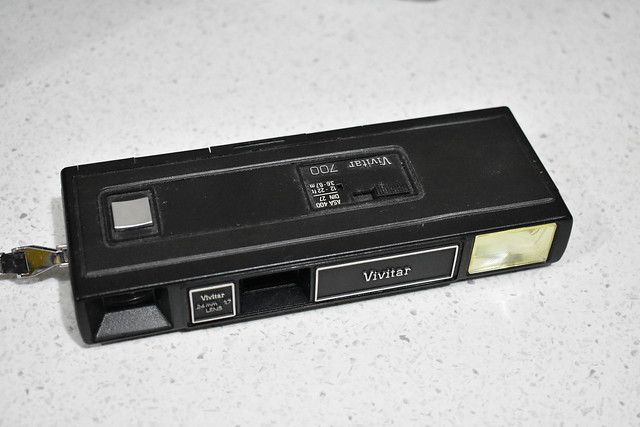Difference between revisions of "Vivitar 700"
(I have one of these now. I haven't used it, but the instruction manual provides some info.) |
(added image from the pool) |
||
| Line 1: | Line 1: | ||
| − | {{ | + | {{Flickr_image |
| + | |image_source= https://www.flickr.com/photos/155643540@N07/43511684675/in/pool-camerawiki | ||
| + | |image= http://static.flickr.com/1857/43511684675_4444a63878_z.jpg | ||
| + | |image_align= | ||
| + | |image_text= | ||
| + | |image_by= Matthew Paul Argall | ||
| + | |image_rights= creative commons | ||
| + | }} | ||
The '''[[Vivitar]] 700''' is one of many cameras for the successful [[110 film]] format. It has a 3-element glass lens (by comparison, a lot of 110 cameras had a plastic lens), and has a built-in electronic flash (via two AA batteries). It appears to date from the late-1970s, and has a typical shape seen in 110 film cameras of the period. | The '''[[Vivitar]] 700''' is one of many cameras for the successful [[110 film]] format. It has a 3-element glass lens (by comparison, a lot of 110 cameras had a plastic lens), and has a built-in electronic flash (via two AA batteries). It appears to date from the late-1970s, and has a typical shape seen in 110 film cameras of the period. | ||
| Line 9: | Line 16: | ||
[[Category:Vivitar]] | [[Category:Vivitar]] | ||
[[Category:110 film]] | [[Category:110 film]] | ||
| + | [[Category:South Korea]] | ||
Revision as of 07:58, 6 September 2018

|
| image by Matthew Paul Argall (Image rights) |
The Vivitar 700 is one of many cameras for the successful 110 film format. It has a 3-element glass lens (by comparison, a lot of 110 cameras had a plastic lens), and has a built-in electronic flash (via two AA batteries). It appears to date from the late-1970s, and has a typical shape seen in 110 film cameras of the period.
Two alkaline AA batteries are needed for the flash, but otherwise the cameras works without batteries. It has a fixed-focus lens (5 feet/1.5 metres to infinity). It accepts both 100 and 400 ISO film.